What Does It Mean When Babies Automatically Like You
Rolling is one of baby's showtime pregnant motor milestones. Hello, mobility!
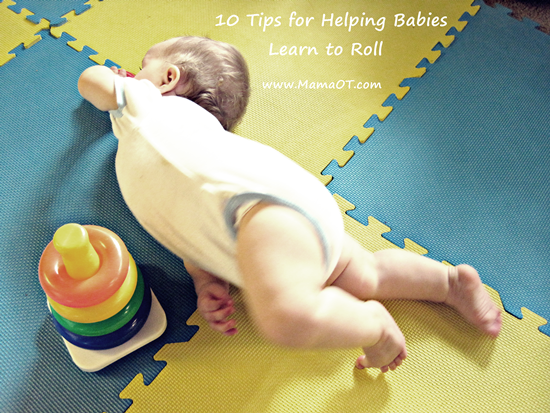
Not simply is rolling the first pace in developing postural control (important for after development of fine motor skills such every bit handwriting), it is too important because it engages a part of the brain responsible for making the left and right sides of the body "talk" to and coordinate with each other (of import for reading, writing, and developing higher motor skills). Cool, huh…or am I the merely nerd in the room?
Some babies are ready to scroll from the starting time, while others take their fourth dimension. On average, babies tend to first roll from tummy to back between 2-5 months, from dorsum to side between 4-5.5 months, and from back to tummy between 5.5-seven.5 months. Regardless of whether babies take the fast or tedious route to rolling, their bodies begin preparing to roll wayyyyyy earlier they ever flip themselves over that very offset time. And, guess what? Yous go to be a office of that preparation! This mail service contains affiliate links for your convenience (see total disclosure hither).
Here are ten tips for helping babies learn how to roll:
1. Set downwards and pick up infant while shifting his weight to the side in a rolling movement.You can beginning this 1 every bit shortly as baby is born and — guess what? — it'southward super piece of cake to incorporate into your daily routine. You tin exercise this with every diaper change and sleep session which means, for a newborn, it can add up to 20 or more than times a day. That's a lot of practice!
Here's how you do information technology: Sit baby on his bottom and roll him over to the side while setting him downwards. He will automatically endeavor to proceed his head from falling out of line with his body (a reflex with which babies are born), strengthening the muscles on the sides of his neck. This move also allows him to practice pushing against the floor with the arm on the way downwardly. Simply contrary this motion when information technology'due south time to pick babe up. Be sure to practice rolling baby to both sides throughout the day…we don't desire a baby who simply moves to one side! Check out the photos below or lookout a brusque video demonstrating this maneuver by clicking here.

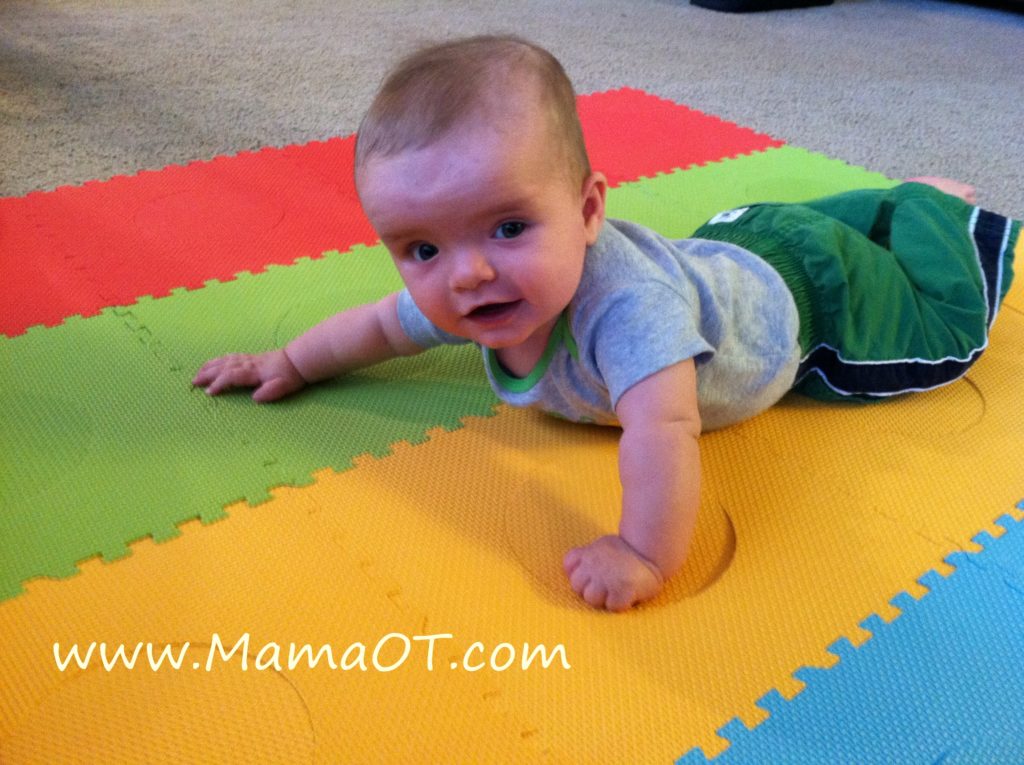
Once your baby is comfy on his tummy and tin push his breast off the floor, yous may notice that he will start to stone his body side to side. This means he's on his way to initiating his new skill of rolling! Information technology may be hours or weeks until he finally topples over for the beginning time, but the fact that he is practicing shifting his weight side to side is HUGE! For some babies who accept problem learning how to whorl, this weight shifting thing is key.
Sometimes babies seem to get "stuck" in that pushed upwardly position and just can't seem to figure out (or are uncomfortable with) shifting their weight side to side. Yous can help with this by guiding him in some tedious, gentle side-to-side motions while he's pushed up equally y'all sing a vocal like Row, Row, Row Your Boat or The Wheels on the Double-deckerand so help him shift his weight to the side just enough that he is able to finish the curl himself at the end of the song or poesy. Yous can also aid your infant shift his weight side to side on an exercise ball (learn more about that here) as he practices this skill in preparation for rolling. Only be sure to be super duper careful, motion slowly, continue your hands on his mid-section at all times, and go on him on top of the brawl (non coming down the side of the ball) and then it doesn't slip out from under you/him.
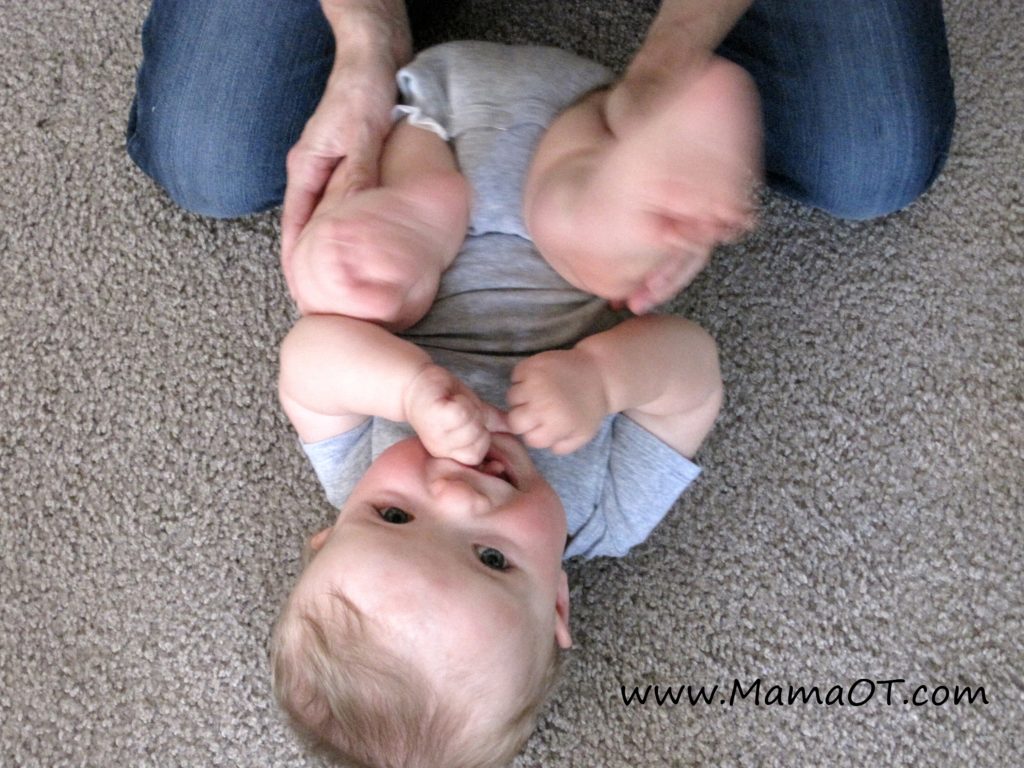
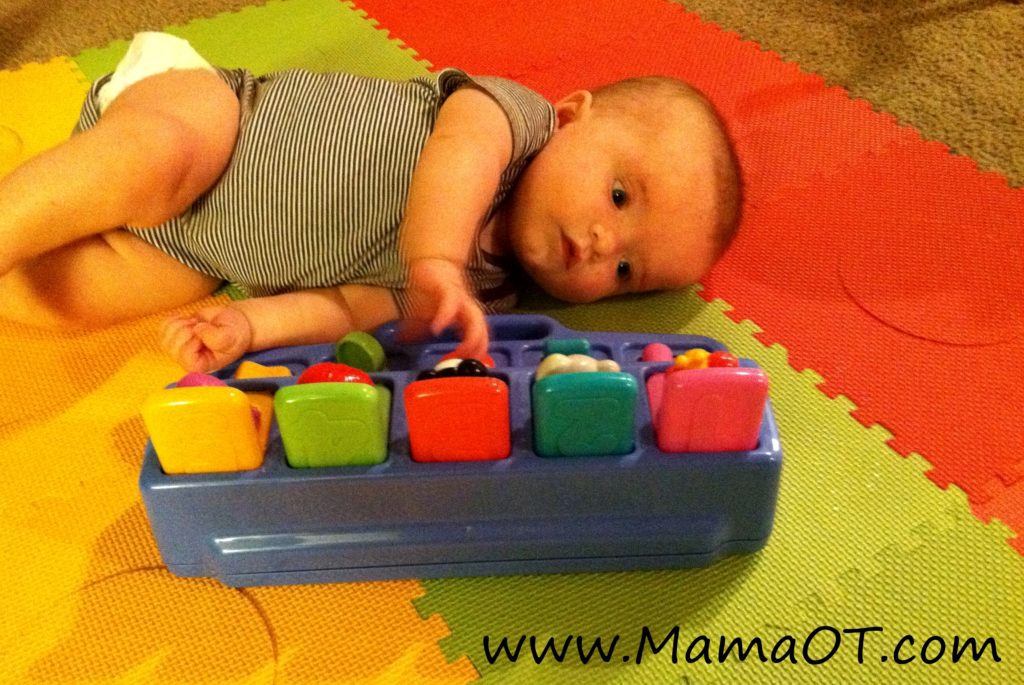
6. Allow baby to spend roughly equal amounts of fourth dimension on all four sides of the torso: tummy, dorsum, left side, right side. This gives baby's body exposure to all positions involved in rolling as she strengthens her neck, body, and artillery. It's as well good for preventing the formation of apartment spots on the dorsum of her caput which, if y'all enquire me, is incentive enough to mix things up throughout the day. Endeavour to vary baby's position virtually every 15-20 minutes.
7. Encourage infant to play at (and cross) his midline. Movement is performed in relation to the invisible line downwards the center of our bodies, and the ability to roll is dependent on a baby'due south ability to come to (and cross) that midline. The great matter is, our center moves with us wherever we go, so midline play tin can be done lying on the dorsum or the side. Babies mostly develop the power to play with their hands in midline betwixt 1-3.v months (while on their back), and are able to expect with their head in midline in this position between four-v months.
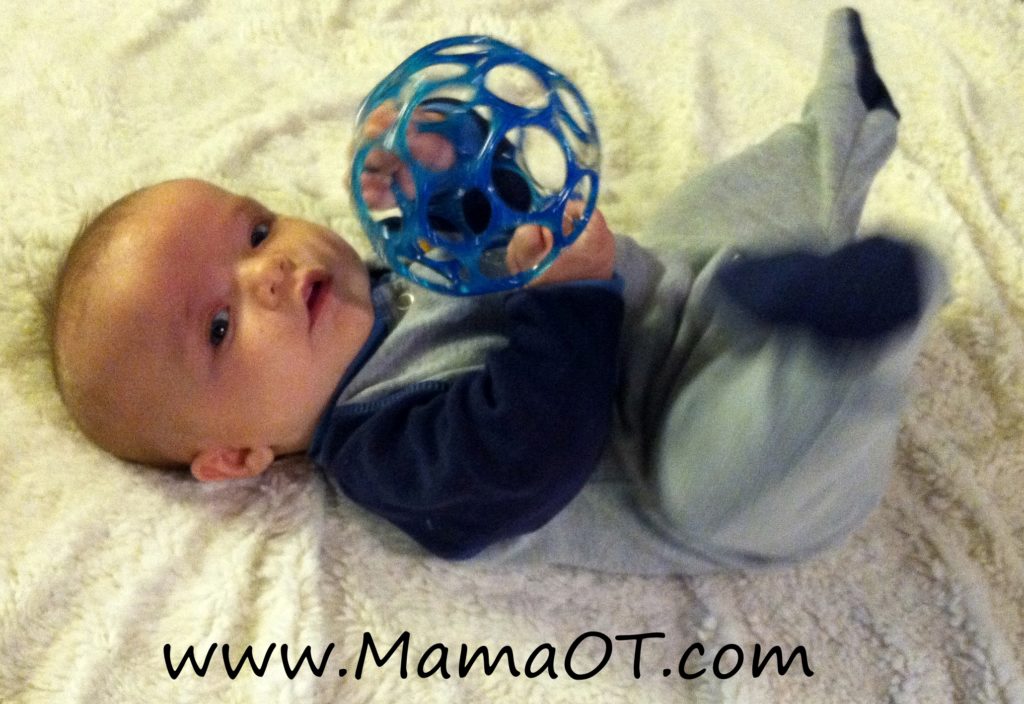
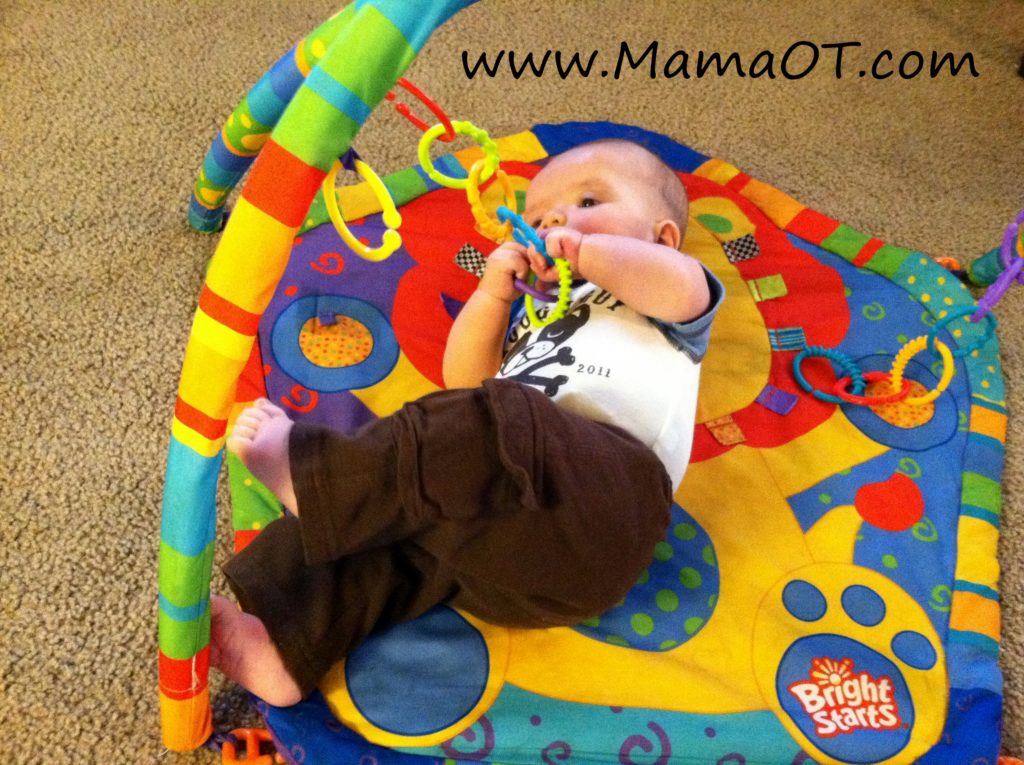
8. Encourage babe to separate movements of upper and lower body. Newborn babies are wired to keep their body in one line, so they'll do a "log gyre" if you try to curlicue them over. The"segmental roll" typically develops between 4-5 months, as they are able to twist and separate the movements of the upper and lower torso while initiating the curlicue with their hips. In one case baby is comfortable playing at midline in the rounded position mentioned earlier, yous can become ahead and move her back and forth through these twisting positions to the rhythm of your favorite children's song (Row, Row, Row Your Boat has won critical acclaim in our household). First with both legs moving together, and then progress to helping babe grab ane foot with the contrary manus. Pause for a second after each twist in society to give infant'south trunk a chance to register the movement, then go along and allow the proficient times roll!
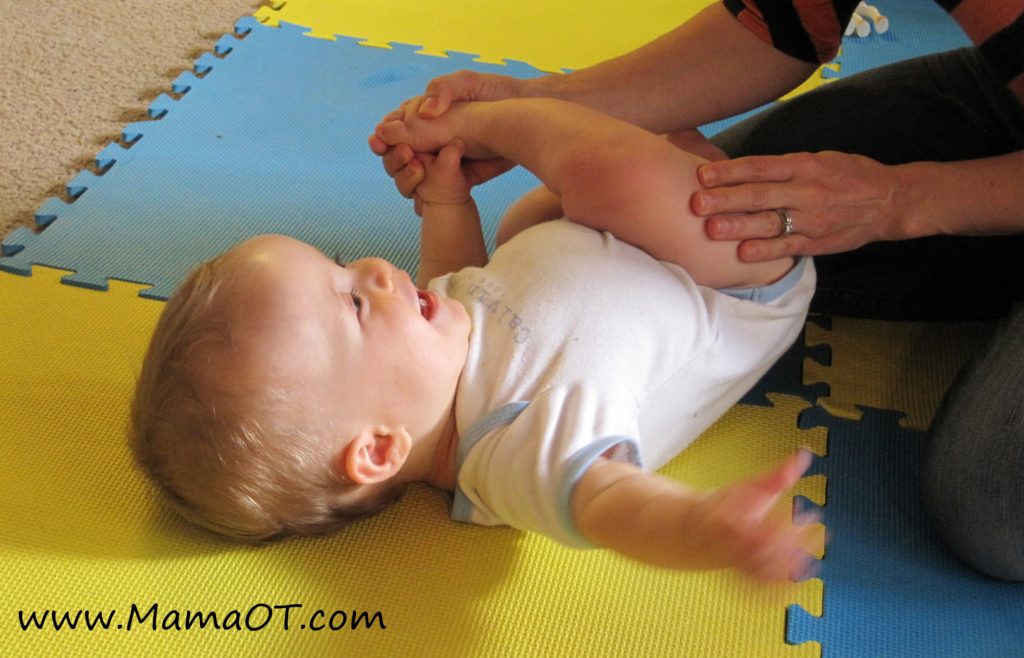
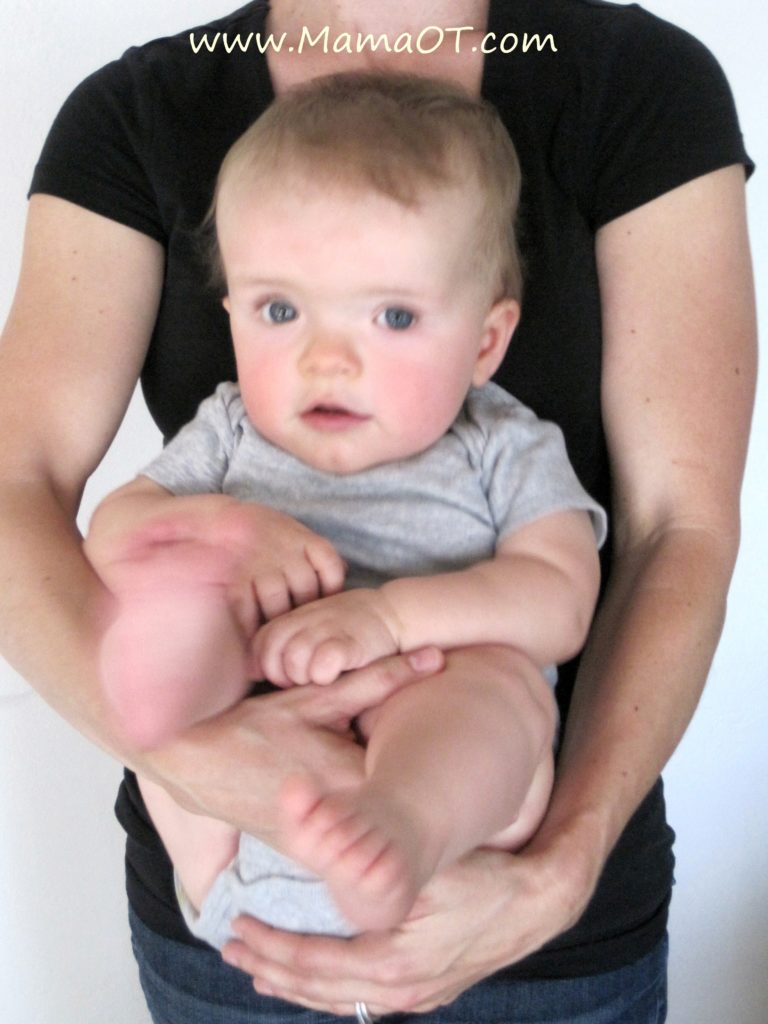

Then at that place you have it! Ten means to assist babies learn how to roll. Don't go overboard with this stuff. We're not training babies for the Infant Olympics! First with the basics, have fun, and let the baby be your guide. Share this data with people you know who may observe it useful…the more who know near information technology, the amend for our babies.
Desire fifty-fifty more tips related to rolling?
The wonderful Starfish Therapies has put together this brusque video and post virtually how to encourage your baby to roll from back to tummy, plus this general post about encouraging rolling, and some other post called "My Child Isn't Rolling Over: Should I Be Concerned?"
And Pediatric OT Anne Zachry has a actually helpful volume called Retro Baby which is filled with tips and activities to assist your baby develop skills such every bit rolling, sitting, and itch. Y'all can read my review of Retro Baby by clicking hither, or you can just head directly to Amazon to see it for yourself.
Alright, fourth dimension to get rolling!
[convertkit form=4884621]
Source: http://mamaot.com/10-tips-for-helping-babies-learn-to-roll/
0 Response to "What Does It Mean When Babies Automatically Like You"
Post a Comment